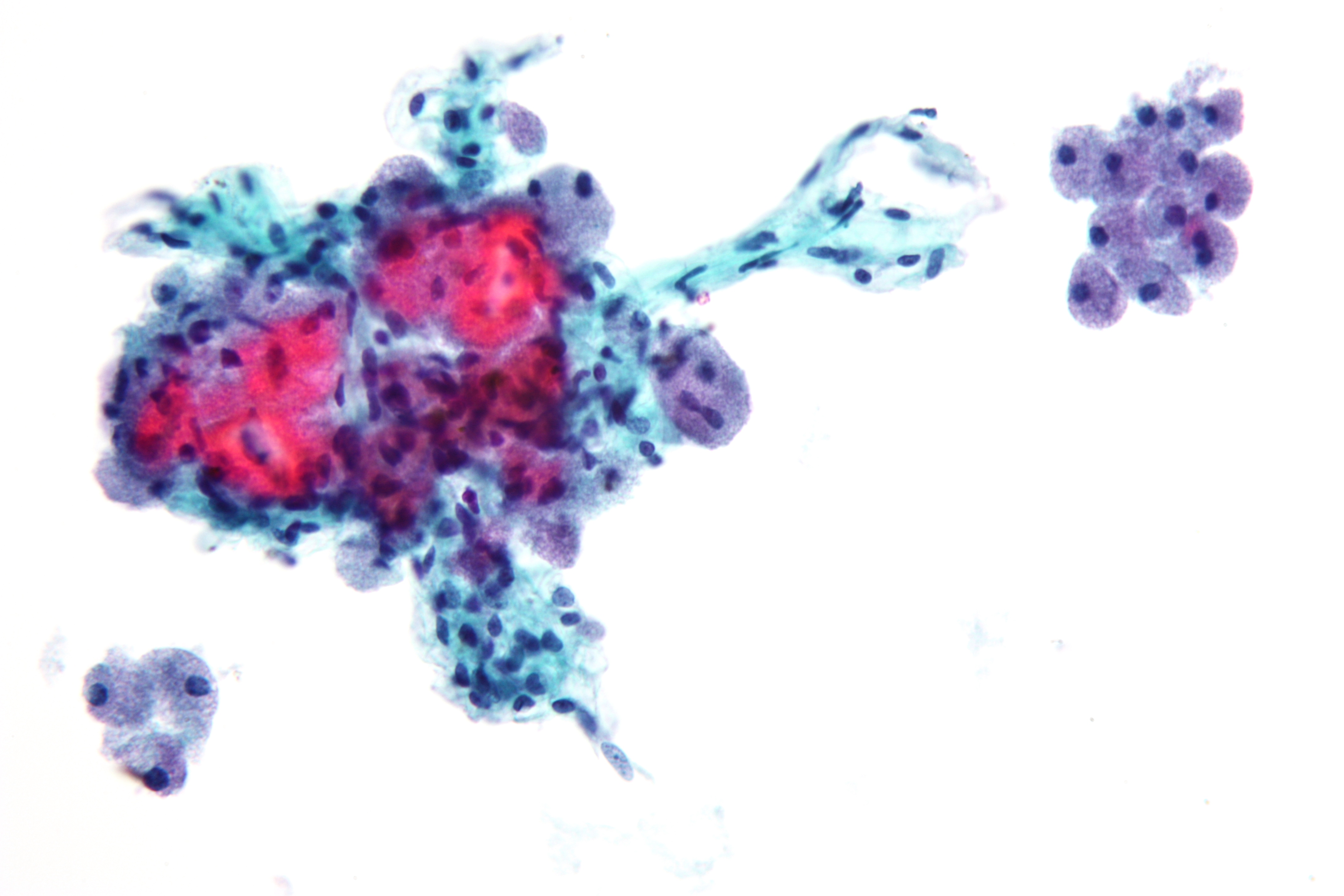Hurthle cells
Editor-In-Chief: C. Michael Gibson, M.S., M.D. [1]; Associate Editor(s)-in-Chief: Furqan M M. M.B.B.S[2]
Overview
Hurthle cells are also called Askanazy cells. They are the specific cells found in the thyroid gland and are visible on the histopathological picture. Hurthle cells have eosinophilic cytoplasm and are abundant in mitochondria. They may be present in a variety of thyroid diseases including Hashimoto's thyroiditis and thyroid carcinoma (Hürthle cel carcinoma; A subtype of follicular thyroid cancer).
Hurthle cells
Hurthle cells are also called Askanazy cells. They are the specific cells found in the thyroid gland and are visible on the histopathological picture. Hurthle cells have eosinophilic cytoplasm and are abundant in mitochondria. They may be present in a variety of thyroid diseases including Hashimoto's thyroiditis and thyroid carcinoma (Hürthle cel carcinoma; A subtype of follicular thyroid cancer).
History
The Hürthle cell is named after German histologist Karl Hürthle, who investigated thyroid secretory function, particularly in dogs. The cell known as the Hürthle cell was first described in 1898 by Max Askanazy, who noted it in patients with Graves' disease. Oncocytes in the thyroid are often called Hürthle cells. Although the terms oncocyte, oxyphilic cell, and Hürthle cell are used interchangeably, Hürthle cell is used only to indicate cells of thyroid follicular origin.[1][2][3][4]
Microscopic Histology
Hurthle cells are also called Askanazy cells. They are the specific cells found in the thyroid gland and are visible on the histopathological picture. They may be present in a variety of thyroid diseases including Hashimoto's thyroiditis and thyroid carcinoma.[5][6][7]
These cells are characterized by the following:
- Large, polygonal cells
- Eosinophilic cytoplasm
- Abundance of mitochondria

|

|

|
Significance of Hurthle cells
Hurthle cells are present in the following conditions:[7]
- Hashimoto's thyroiditis
- Grave's disease
- Benign thyroid adenomas
- Follicular thyroid carcinoma
Diagnosis
Hürthle cell adenomas are more frequent than Hürthle cell carcinomas. It is difficult to differentiate between being benign or malignant Hürthle cell lesions. Chronic lymphocytic thyroiditis or Hashimoto's thyroiditis, along with cases of long-standing Graves' disease, show Hürthle cells present. Classification is important since widely invasive tumors can have outcomes with a 55% mortality rate. Hürthle cell carcinomas consist of at least 75% Hürthle cells.[5][6][10]
- Size and growth pattern of the tumor cannot be used to determine malignancy, although larger tumors have a higher incidence of malignancy, Hürthle cell adenomas and carcinomas are differentiated on the basis of capsular and vascular invasion.
- Tumors displaying only capsular invasion tend to behave less aggressively than those with vascular invasion.
- Hürthle cell carcinomas are characterized as either minimally invasive or widely invasive tumors.
- The minimally invasive or encapsulated carcinoma is fully surrounded by a fibrous capsule.
- The widely invasive carcinoma shows an extensive area of both capsular and vascular invasion with the leftover capsule typically difficult to identify.
Treatment
The appropriate diagnosis of the underlying cause of the Hurthle cells in the histological picture directs the treatment.[5]
- Grave's disease and Hashimoto's thyroiditis are usually treated for hyperthyroidism and hypothyroidism respectively.
- A non-minimally invasive Hürthle cell carcinoma is typically treated by a total thyroidectomy followed by radioactive iodine therapy.
- A Hürthle cell adenoma or a minimally invasive tumor can be treated by a thyroid lobectomy, although some surgeons will perform a total thyroidectomy to prevent the tumor from reappearing and metastasizing.
References
- ↑ Cannon J (2011). "The significance of hurthle cells in thyroid disease". Oncologist. 16 (10): 1380–7. doi:10.1634/theoncologist.2010-0253. PMC 3228061. PMID 21964000.
- ↑ "Endocrine Pathology". Retrieved 2009-05-07.
- ↑ Aytug, Serhat (June 13, 2006). "Hurthle Cell Carcinoma". eMedicine.
- ↑ "Beiträge zur Kenntniss des Secretionsvorgangs in der Schilddrüse | SpringerLink".
- ↑ 5.0 5.1 5.2 Schwab, M. (2011). Encyclopedia of Cancer. Encyclopedia of Cancer. doi:10.1016/B0-12-227555-1/00151-9
- ↑ 6.0 6.1 Montone, Kathleen T., Zubair W. Baloch, and Virginia A. LiVolsi. "The thyroid Hurthle (oncocytic) cell and its associated pathologic conditions: a surgical pathology and cytopathology review." Archives of Pathology and Laboratory Medicine 132.8 (2008): 1241-1250.
- ↑ 7.0 7.1 Anderson EL, Frischholz EJ, Trentalange MJ (1988). "Hypnotic and nonhypnotic control of ventilation". Am J Clin Hypn. 31 (2): 118–28. doi:10.1080/00029157.1988.10402878. PMID 3228061.
- ↑ "www.pathologyoutlines.com".
- ↑ "Hurthle cell adenoma-histology 40x H&E | Contributed by Grac… | Flickr".
- ↑ Erickson, Lori A. "Hurthle Cell Thyroid Neoplasms." Atlas of Endocrine Pathology. Springer New York, 2014. 63-66.